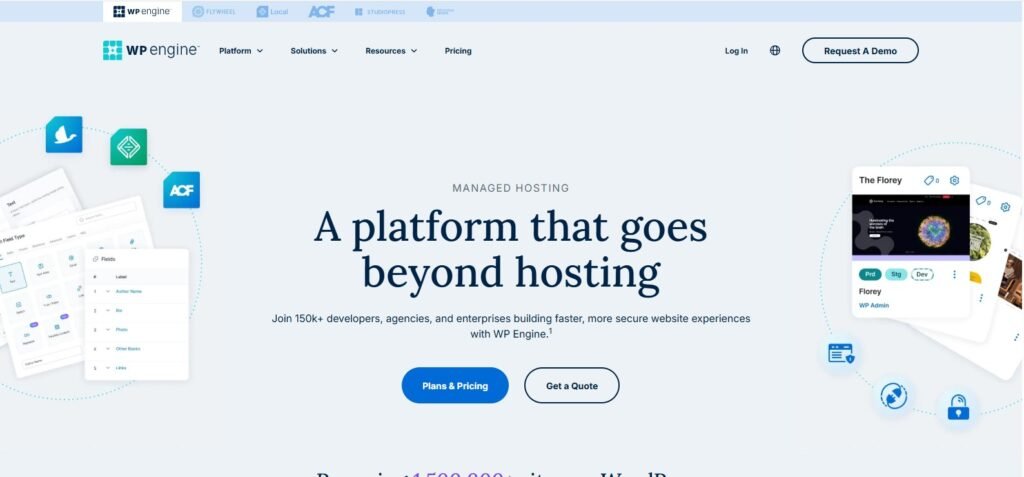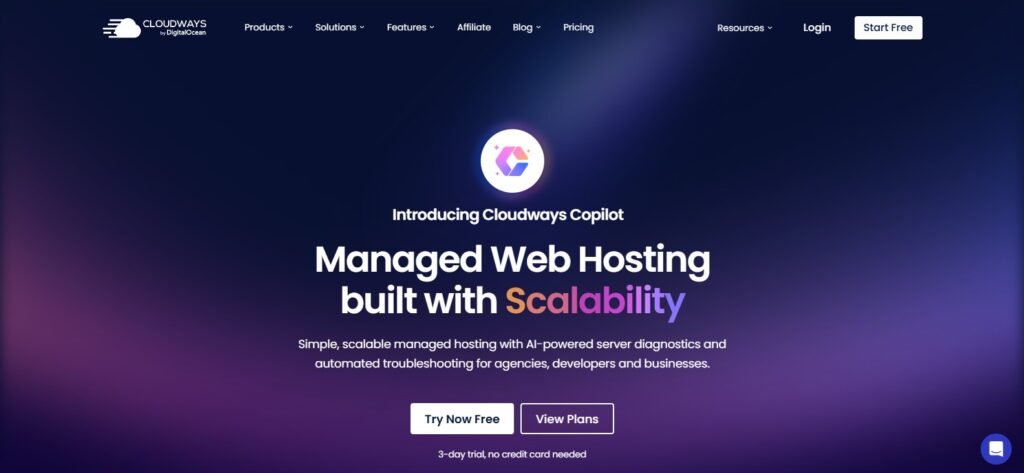Reaching 100,000 monthly visitors is an incredible milestone for any eCommerce business — but it’s also when cracks start showing in your infrastructure. Pages load slower, the checkout process lags, and database queries take longer to complete. What once worked on a $10 shared plan can now cost you sales.
At this scale, performance isn’t optional — it’s a direct revenue factor. Google research shows that a 1-second delay in load time can reduce conversions by up to 7%. That means even a small hosting bottleneck could cost thousands of dollars in lost orders each month.
This article walks you through how to choose the fastest WordPress hosting for an eCommerce store serving around 100K monthly visitors — focusing on real-world speed, scalability, and reliability, not marketing hype.
Understanding the Demands of a 100K-Visitor eCommerce Store
At 100,000 visits per month, your WordPress store processes more than just page views. Every click triggers dynamic queries, cart updates, AJAX calls, and payment gateway communications. Unlike blogs or brochure sites, eCommerce platforms use CPU-heavy plugins such as WooCommerce, Elementor, and caching engines that demand high-performance servers.
Your hosting needs to handle:
- Dynamic PHP requests for checkout, user sessions, and product filtering.
- Database transactions for orders, stock management, and customer data.
- Image delivery and caching for high-volume product pages.
- Security layers like firewalls, SSL encryption, and bot protection.
For 100K visitors, expect anywhere between 200GB to 400GB of monthly bandwidth, depending on how image-heavy your catalog is. Your host must comfortably handle that without throttling.
Why Speed Matters Beyond SEO
Fast hosting doesn’t just boost rankings — it directly affects revenue. A 1-second improvement in load speed can increase conversions by 10–15%. Customers today expect eCommerce sites to load within two seconds, even during peak sales periods like Black Friday.
Moreover, platforms like Google Ads and Facebook Ads factor in landing page speed as part of their quality score. Faster pages lower your cost per click, meaning the right hosting saves you money on both infrastructure and marketing.
Hosting Essentials for a 100K-Visitor eCommerce Site
When evaluating hosting providers, focus on these key technical capabilities:
1. Dedicated Resources (No Shared CPU)
At this traffic level, shared hosting is out of the question. You need dedicated resources — at least 4–8 CPU cores and 8–16GB RAM — to process multiple simultaneous users.
2. NVMe SSD Storage
Modern eCommerce sites rely heavily on read/write operations. NVMe drives are up to 6x faster than standard SSDs, drastically improving database response times and checkout speeds.
3. Built-in Caching Layers
Your host should offer advanced caching — page caching, object caching, and opcode caching (OPcache). This minimizes server load and boosts speed for returning visitors.
4. Global CDN Integration
With 100K visitors, chances are your audience spans multiple countries. A CDN (Content Delivery Network) ensures static files — like images, scripts, and styles — load from the nearest server to each user.
5. PHP 8.2+ and HTTP/3 Support
Modern PHP versions handle requests more efficiently, while HTTP/3 enhances speed and security for concurrent connections (like during checkout).
6. Automatic Scaling
Even with consistent traffic, spikes happen — during sales or product launches. Your host must allow vertical scaling (adding CPU/RAM) and auto-scaling for traffic bursts.
Choosing Between Managed and Unmanaged Hosting
For most eCommerce stores, managed WordPress hosting is the smartest option. It handles updates, server optimization, caching, and security automatically — saving you hours of DevOps work.
Unmanaged VPS or cloud servers (like DigitalOcean or AWS) offer more control but require technical expertise to configure performance tuning, firewalls, and backups. Unless you have an in-house admin, the management overhead outweighs the savings.
Best Fast WordPress Hosting Providers for 100K Monthly Visits
1. Kinsta – Enterprise Performance for Growing Stores

Kinsta runs on Google Cloud’s Premium Tier network — the same infrastructure used by major SaaS platforms. Their containerized architecture ensures your store runs in isolated resources, meaning traffic surges from other sites never affect you.
Features include:
- Auto-scaling and dedicated PHP workers for WooCommerce.
- Redis object caching for lightning-fast product pages.
- Cloudflare Enterprise CDN built-in (275+ PoPs).
- 24/7 expert support with eCommerce-specific optimization help.
Kinsta is ideal if you prioritize zero maintenance and maximum uptime. Pricing starts around $35/month but scales based on usage.
Best for: Mid-to-large stores needing stability during high-traffic campaigns.
2. WP Engine – Reliable Speed and WooCommerce Optimization

WP Engine is built specifically for WordPress and WooCommerce. It combines caching, CDN, and security into one platform. Their EverCache technology keeps dynamic content fast while minimizing resource consumption.
What makes WP Engine stand out is its multi-environment setup — development, staging, and production. You can test updates without risking your live site.
Performance Highlights:
- Integrated Cloudflare CDN + caching.
- Automated daily backups.
- Optimized database and PHP environment.
- 99.99% uptime SLA.
Best for: Stores running marketing campaigns where speed and uptime directly affect sales.
3. Cloudways – Developer-Friendly Power and Flexibility

Cloudways bridges managed hosting with full control. It lets you deploy your WordPress store on top-tier cloud platforms like DigitalOcean, Vultr, AWS, or Google Cloud — all with managed optimization.
For eCommerce stores with 100K monthly visits, Cloudways is one of the most cost-efficient choices. Their built-in caching stack (Varnish + Memcached + Redis) keeps load times below one second even under heavy traffic.
Best for: Startups or technical teams wanting control without managing servers manually.
A $36/month plan with 4 vCPUs and 8GB RAM easily handles 100K+ visits when optimized properly.
4. SiteGround Cloud – Affordable Managed Cloud for WooCommerce

SiteGround’s cloud platform is tailored for mid-sized WordPress stores. Powered by Google Cloud infrastructure, it offers fully managed performance, free staging, and daily backups.
Their in-house Ultrafast PHP setup significantly improves dynamic request handling, which is vital for eCommerce stores processing multiple carts simultaneously.
Why it’s great: It delivers near-Kinsta performance at a lower cost, making it ideal for stores transitioning from shared to cloud hosting.
5. Hostinger Cloud Business – Budget Speed with NVMe Power
Hostinger’s Cloud Business plan is the most affordable way to achieve cloud-level speed. With NVMe storage, LiteSpeed caching, and a built-in CDN, it can easily handle traffic spikes from 100K visitors.
While not as advanced as Kinsta or Cloudways, it offers an excellent balance of price and power for smaller stores or regional audiences.
Best for: Budget-conscious stores that still need fast, reliable hosting for large traffic volumes.
Performance Optimization for 100K+ Traffic
Even the best host can’t compensate for poor site optimization. To sustain 100K visitors per month, your WordPress and WooCommerce configuration must be fine-tuned.
1. Optimize Database Queries
WooCommerce stores can accumulate thousands of orders and post meta entries. Use plugins like WP-Optimize to clean old data, transient cache, and overhead.
2. Limit Plugins and Use Lightweight Themes
Every plugin adds load. Stick to essential ones — caching, security, and SEO — and use performance-friendly themes like Astra, GeneratePress, or Blocksy.
3. Implement Full-Page and Object Caching
Dynamic caching via Redis or Memcached can reduce database calls by 70%. Combine that with page caching for guests and shoppers who aren’t logged in.
4. Use a Global CDN
For 100K visitors, serving images and assets from a CDN is non-negotiable. It reduces latency and offloads bandwidth from your main server.
5. Optimize Images and Videos
Use WebP format and lazy-load non-critical assets. Tools like Imagify or ShortPixel automate compression without quality loss.
Monitoring and Maintenance
Once you’re handling high traffic, continuous monitoring becomes part of daily operations.
- Use uptime monitors (e.g., UptimeRobot or BetterStack) to catch downtime immediately.
- Set server alerts for CPU and RAM usage thresholds.
- Schedule weekly backups and verify restore functionality.
- Run staging tests before updating WooCommerce, PHP, or plugins.
Your hosting provider should handle most of this automatically, but proactive monitoring keeps you ahead of potential issues.
Security Considerations
A 100K-visitor store is a bigger target for attacks. Ensure your host includes:
- Built-in malware scanning and real-time firewalls.
- Daily automatic backups and one-click restore.
- Free SSL certificates across all subdomains.
- DDoS protection and rate-limiting.
- Bot filtering to prevent fake traffic and checkout spam.
If your host doesn’t include these, add Cloudflare’s free plan for extra security and caching benefits.
Scaling for Future Growth
If your store already attracts 100,000 visitors, you’re on track for 200K soon. Prepare your infrastructure early. Choose a host that allows:
- Vertical scaling: Add resources without migrating.
- Horizontal scaling: Load balance across multiple servers.
- Global server locations: Reduce latency for international shoppers.
Managed cloud providers like Kinsta and Cloudways make scaling seamless — no downtime, no DNS changes, just instant capacity increases when traffic surges.
Realistic Cost Expectations
Expect to pay between $30 and $120 per month for quality hosting capable of handling 100K visitors comfortably. Anything cheaper risks performance bottlenecks or hidden bandwidth caps.
Here’s a quick benchmark:
- Budget Tier: Hostinger Cloud (~$9.99–$14.99)
- Mid-Tier: Cloudways, SiteGround Cloud (~$30–$60)
- Premium: Kinsta, WP Engine (~$70–$120)
Remember: hosting cost is a fraction of total revenue impact. A site that loads one second faster can pay for the upgrade in days through higher conversion rates.
Common Mistakes to Avoid
- Using shared hosting: It’s the biggest performance killer at this scale.
- Ignoring database optimization: Large WooCommerce stores degrade quickly without maintenance.
- Skipping backups: One corrupted update can cost thousands in lost sales.
- Not testing under load: Always simulate real-world traffic before major campaigns.
- Choosing based on marketing hype: Focus on verified benchmarks and uptime, not free domain offers.
FAQs
Q1: Can shared hosting handle 100K monthly visitors?
No. Shared environments throttle CPU and memory during spikes, causing slow checkouts and cart abandonment.
Q2: How many PHP workers do I need for 100K visits?
At least 6–10 dedicated PHP workers for WooCommerce stores. More workers mean faster handling of concurrent sessions.
Q3: What’s the average load time I should aim for?
Under 2 seconds for homepage and product pages, under 3 seconds for checkout.
Q4: Which caching setup works best for WooCommerce?
Redis object caching + server-level full-page caching, with cache exclusions for cart and checkout pages.
Q5: Should I choose a host with data centers in my target region?
Absolutely. Hosting near your audience reduces latency and improves Core Web Vitals.
Conclusion
At 100K monthly visits, your WordPress store is no longer small — it’s a high-performance eCommerce engine that needs enterprise-level stability. Choosing the right hosting isn’t about saving a few dollars; it’s about protecting your revenue, reputation, and user experience.
Invest in a fast, scalable cloud host like Kinsta, Cloudways, or SiteGround Cloud, pair it with solid optimization and caching, and you’ll be equipped to handle not just 100K — but 1 million monthly visits with confidence.
Because in eCommerce, speed isn’t a feature — it’s the foundation of trust, conversions, and growth.



